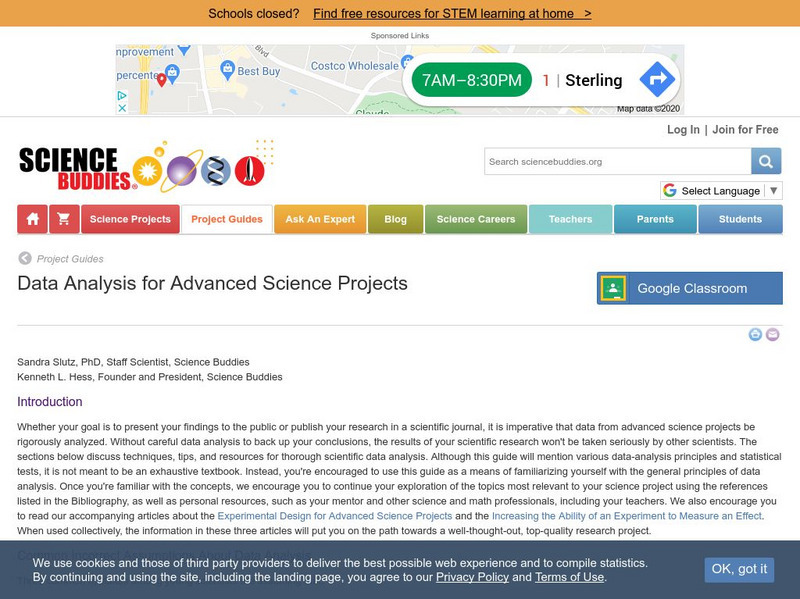Science Buddies
Science Buddies: Determining Iodide Content of Salt
In this week long "kitchen chemistry" project you will use chemicals from the supermarket to test for the presence of iodine and iodide in salt. These are common micronutrients added to some preparations of table salt. A materials list,...
Science Struck
Science Struck: Metalloids in the Periodic Table
Discusses the history and organization of the periodic table, where the metalloids fit in, and their properties. Includes color-coded periodic table of elements.
Science Buddies
Science Buddies: Data Analysis for Advanced Science Projects
The importance of data analysis in science projects is explained. Describes common mistakes young scientists make. The article then discusses how to find out what the standard methods of data analysis are for the type of research you...
Science Buddies
Science Buddies: Design Requirement Examples
The design requirements for a science project will differ from those of anyone else because it will apply to a specific problem statement and the product, system, or experience that is being designed. In the table, are some examples of...
Crescent Public Schools
The Internet Science Room: The Periodic Table and Atomic Theory of Matter
A chemistry tutorial highlighting historical development of the atomic theory of matter and the periodic table of elements.
Savvas Learning
Chemistry, the Central Science: Enthalpies of Formation
A section from a textbook about enthalpies of formation. Includes practice exercises, a table of enthalpy values, and examples.
Science Struck
Science Struck: Inner Transition Metals
Discusses the organization of the periodic table into periods and groups, then looks at where the Lanthanoids and Actinoids are situated, and their properties.
Science Struck
Science Struck: 26 Funny Periodic Table Puns
A humorous collection of periodic table puns.
Science Struck
Science Struck: Printable Periodic Table of Elements With Names
Provides two printable periodic tables, color-coded to show the element groups. One table gives masses, the other gives charges.
Science Struck
Science Struck: Periodic Table Facts
Learn about the different groups of elements that make up the periodic table and some interesting facts about it.
Alabama Learning Exchange
Alex: "Electron" Ic Battleship
The students will play a game of Battleship on the Periodic Table to review electron configuration of the elements.This lesson plan was created as a result of the Girls Engaged in Math and Science University, GEMS-U Project.
Science Struck
Science Struck: Significant Inventions of the Industrial Revolution
This resource presents a long list of important inventions during the First Industrial Revolutions, organized consecutively from 1701-1839. Includes short descriptions and images. This is followed by a table listing inventions from the...
Science Struck
Science Struck: A Layman's Guide to How a Sling Psychrometer Works
A sling psychrometer is used to measure humidity levels. Read about its history, how it works, its design, and how to use it. Includes a relative humidity table.
Crescent Public Schools
The Internet Science Room: Electron Configuration and Orbital Diagrams
Students use this chemistry tutorial to guide their understand of electron configuration and orbital diagrams.
Scientific American
Scientific American: Earthquake Proof Engineering for Skyscrapers
Students construct a shake table, then build towers of different heights using Lego blocks, and test their stability on this platform. Next, they test towers with different sized bases, and towers made using different materials.
Science Struck
Science Struck: Richter Scale Explained
Explains what the Richter scale is and how the Richter formula is used to measure the magnitude of earthquakes. Includes a table of Richter values showing the changes in characteristics, impact, and frequency of tremors and earthquakes...
Science Struck
Science Struck: Metric Measurements: Units and Conversions
Discusses how the metric system of measurement was developed and provides tables of unit conversions within the metric system, within the Imperial system, and between the two systems.
Alabama Learning Exchange
Alex: Ice Cream Sundae Survey
Learners quickly realize the importance of learning how to read and find information in charts, graphs, and tables compared to finding the same information written in a paragraph. This is a fun, high energy lesson!This lesson plan was...
Science Struck
Science Struck: Properties of Halogens
Looks at the chemical and physical properties of halogens.
Science Struck
Science Struck: Characteristics of Halogens
Learn about the characteristics, chemical and physical properties, and uses of halogens.
Annenberg Foundation
Annenberg Learner: The Habitable Planet: Ecology Lab
Create the parameters of your own ecosystem by choosing which producers and consumers live there. Visualize how the food web operates and species populations change. This simulator mimics the food web within a typical ecosystem and gives...
US Geological Survey
Usgs: Ground Water: Wells
Wells are extremely important to all societies. Find out how wells are dug today and peruse the list of the different types of wells and the methods used to dig them. Click Home to access the site in Spanish.
Annenberg Foundation
Annenberg Learner: The Habitable Planet: Water Resources
Learn about water as a precious resource in danger of being depleted. Understand the roles that overuse and agricultural use play in the sustainability efforts of this essential resource. Includes video. [28:25]
ibiblio
Ibiblio: How Many? A Dictionary of Units of Measurement
The Center for Mathematics and Science Education at the University of North Carolina at Chapel Hill provides an interesting and easy-to-use dictionary of the history and meaning of many measurement terms. Metric, International, and...
Other popular searches
- Science Data Tables
- Reading Tables Science
- Making Tables Science
- Periodic Tables Science
- Input/output Tables Science








